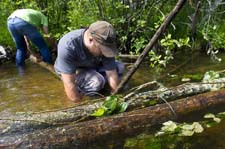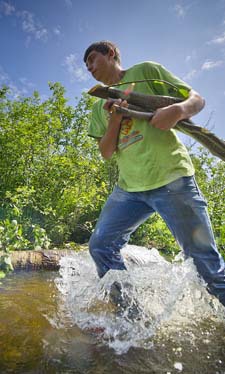Partnerships key to success of upper Black River brook trout fishery
Michigan Department of Natural Resources sent this bulletin at 07/17/2014 05:19 PM EDT|
Your weekly Showcasing the DNR feature story & photos |
 |
 |
 |
 |
 |
Showcasing the DNR
Partnerships key to success of upper Black River brook trout fishery
Although the late author and avid fly-fisherman Ernest Hemingway is well known for writing about the Upper Peninsula’s Two-Hearted River (which was actually the Fox River incognito), there are other trout streams in Michigan that he held so dear, they didn’t even appear in his short stories – only in letters to trusted friends and confidantes.
The northeastern Lower Peninsula’s upper Black River, long recognized as one of Michigan’s best brook trout streams, was one of those hush-hush Hemingway haunts that today, through the work of a strategically aligned group of partner organizations, has become a destination point for anglers chasing wild brookies.
“It’s renowned for its wild brook trout population,” said Tim Cwalinski, the Department of Natural Resources fisheries biologist who manages waters within the Black River Watershed. “We get pretty good survival and growth and it is a destination for anglers who want to fish for brook trout, particularly the East Branch, the mainstream and Canada Creek.”
But that doesn’t mean it can’t be even better. And a unique group of partners – known as the Upper Black River Council – has been doing its best to make it so.
Originally formed in the early 1990s, specifically to deal with problem beaver dams that impounded and warmed the water, the council has expanded its mission into the restoration and preservation of the watershed, which it recognizes as “a highly prized multiple use natural resource.”
 The Upper Black River Council is made up of a wide variety of organizations and individuals – the DNR Fisheries Division, U.S. Fish and Wildlife Service, Huron Pines (a conservation group), private landowners, Canada Creek Ranch, Black River Ranch, the Tip of the Mitt Watershed Council, and the Northeast Michigan Council of Governments (NEMCOG) among them. They all add up to an award-winning crew that gets things accomplished.
The Upper Black River Council is made up of a wide variety of organizations and individuals – the DNR Fisheries Division, U.S. Fish and Wildlife Service, Huron Pines (a conservation group), private landowners, Canada Creek Ranch, Black River Ranch, the Tip of the Mitt Watershed Council, and the Northeast Michigan Council of Governments (NEMCOG) among them. They all add up to an award-winning crew that gets things accomplished.
“It’s something that has evolved over time, a collaborative partnership,” said Carol Rose, chair of the Upper Black River Council. “There’s no final arbitrator for the decisions we make. We meet two or three times a year, talk about the needs of the resources, who might have funding or could get funding, set priorities, and get to it.”
Recent council efforts on the Black River include improving road/stream crossings, removal of dams (built by humans as well as beavers), and placement of large woody debris, which provides a number of benefits to the river and its residents.
The woody-debris structures – which are built in a trapezoid-type shape – are designed to perform a variety of functions according to Cwalinski. They provide diverse in-stream cover for both juvenile and adult trout; accumulate silt (uncovering coarser substrates mid-channel that may provide spawning habitat for trout); provide additional surface area for aquatic insects; and stabilize erodible banks.
“Some structures are built in order to capture sand and sediment and build bank,” Cwalinski explained. “And while that might have been the goal of the structure, the ends of the structure – further out in the stream – are still being used by adult fish.
“Every piece of wood we put in there becomes a base for the food chain. You have insects that use it, you have bait fish that live under it, you have turtles that bask on it. These are all side benefits for the primary purpose. For the most part, if you’re doing something for one reason, it’s also helping other causes.”
Cwalinski said the council is invaluable to accomplishing goals he’s had his eye on, but that were dependent on help from outside resources.
“I can’t get all of this work done with just my staff, we don’t have the manpower,” said Cwalinski. “Thank goodness I’ve got this council who can help maintain and rehabilitate the river. Fisheries Division quantifies habitat and fish populations in the watershed, but the watershed council and its members supplement our preservation and enhancement efforts. ”
Nico Tucker, a transportation and natural resources planner with NEMCOG, oversees the four-man work crew on the Black River. A former hands-on river restorer himself, Tucker says his crews have put in more than 1,000 structures and enhanced 8 to 9 miles of river since he took on the job in 2007.
Tucker said he usually walks the stream with Cwalinski, identifying areas that can use structures, and then he compiles the permit application. He serves as liaison to the council, which comes up with funding for the projects.
“There are some stretches where it’s just large, flat, open stretch and we place appropriate structures to diversify the habitat,” Tucker said. “What we put into the stream depends a great deal on what’s already there.”
One recent achievement is the removal of Saunders Dam, which was on private property purchased by the DNR through a Natural Resources Trust Fund grant. Fisheries Division evaluated the dam, decided it should be removed, and then worked with a variety of partners to get it done. As a result, the trout now have unhindered access to 8 more miles of river upstream.
“The Fish and Wildlife Service provided a fish passage grant, Huron Pines helped administer the grants – it’s a true partnership overseeing this watershed, under the oversight of the Black River Council,” Cwalinski said.
Cwalinski said the private ranches often use the work crews to maintain and enhance their stretches of stream, then pay for the service – a working relationship that benefits everyone.
“This is one of the best-organized watershed groups we work with,” Cwalinski said. “I wish we had these for the other watersheds up here. The Upper Black River Council is there to improve, maintain and give back to the watershed. I consider myself very lucky to have this group to work with.”
To learn more about trout fishing opportunities in Michigan, visit www.michigan.gov/fishing. Additional information about the Upper Black River Council can be found at www.upperblack.org.
###
Note to editors: Photos to accompany this story are available for download at www.michigandnr.com/ftp/OutReach/ in the folder marked "Black River habitat work".
**Credit photo: Michigan DNR
Captions:
DSK501_145: Members of the Upper Black River Council help place structure to improve trout habitat on the upper Black River in the northeastern Lower Peninsula.
DSK501_146: Woody debris placed in the upper Black River by council members diversifies the aquatic habitat, with direct benefits for trout, turtles, insects, bait fish and more.
DSK501_157: Upper Black River Council members don’t just discuss goals and plans for the river – they provide the manpower necessary for the completion of desired projects.
DSK501_182: Council members complete field work to enhance the upper Black River with guidance from professional natural resource managers who are part of the council.
DSK501_195: Upper Black River Council work crews have placed more than 1,000 habitat improvement structures and enhanced approximately 9 miles of river in the past seven years.
July 17, 2014 -- This story has a word count of 964.
Showcasing the DNR was originally designed for weekly news publications, but we invite everyone to share these stories with friends, family and anyone who would like to learn more about Michigan’s great outdoors and cultural heritage. Media organizations are welcome to cut and paste these stories for use with their own readers and website visitors. Use the Internet link (at the end of this email) to access photos to supplement the story.
Thank you for your interest in Showcasing the DNR. See past editions at www.michigan.gov/dnr-stories. Questions or comments? Please contact DNR deputy public information officer Debbie Munson Badini at 906-226-1352 or badinid@michigan.gov.